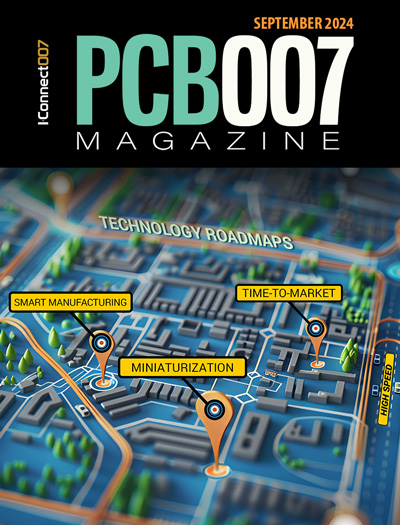-

- News
- Books
Featured Books
- pcb007 Magazine
Latest Issues
Current Issue
Engineering Economics
The real cost to manufacture a PCB encompasses everything that goes into making the product: the materials and other value-added supplies, machine and personnel costs, and most importantly, your quality. A hard look at real costs seems wholly appropriate.

Alternate Metallization Processes
Traditional electroless copper and electroless copper immersion gold have been primary PCB plating methods for decades. But alternative plating metals and processes have been introduced over the past few years as miniaturization and advanced packaging continue to develop.

Technology Roadmaps
In this issue of PCB007 Magazine, we discuss technology roadmaps and what they mean for our businesses, providing context to the all-important question: What is my company’s technology roadmap?
- Articles
- Columns
Search Console
- Links
- Media kit
||| MENU - pcb007 Magazine
Pioneer Circuits’ Solutions Used in NASA's PUFFER Collapsible Bot
February 5, 2018 | Pioneer CircuitsEstimated reading time: 2 minutes
The PUFFER (Pop-Up Flat Folding Explorer Robot) collapsible micro-rover is a part of NASA’s “Game Changing Development Program.” It is a compact rover that will ride on board with future space vehicles to land on space bodies such as planets and asteroids for photographs and microanalysis.
Figure 1: The original PUFFER prototype before working with Pioneer Circuits for the new hinge technology.
The PUFFER micro-rover utilizes a new, patented hinge technology containing a high-temperature woven fabric that is compatible with PWB rigid-flex manufacturing. JPL utilized Pioneer Circuits’ concurrent engineering services to help with the new developments that were a key enabler for the PUFFER project.
The Challenge
The PUFFER’s concept addresses the challenge of developing robotic mobility in space exploration. The PUFFER challenge was to design a micro-rover capable of surviving the harsh environments of deep space while also being able to collapse and fold into more compact forms that will fit into small areas for detailed photographs and surface analysis.
The original PUFFER prototypes were having issues with passing their cycle and drop test operations. Design challenges included the mechanical design of the rigid-flex PCB joints to be able to work on a repeatedly folding robot structure, and for the PCB’s copper traces to last the lifetime of the rover. The original materials used for the joints were not compatible with current PCB manufacturing processes, and the PUFFER was only able to withstand 1,000 test cycles—a very conservative number for a Mars application.
Through concurrent engineering, Pioneer Circuits found the material and developed a high-temperature woven fabric hinge technology that is compatible with PCB rigid-flex manufacturing. The rigid-flex circuit technology is integrated into a highly reliable, composite structure that is the first origami micro-rover configuration ever developed.
Figure 2: A close-up of Pioneer Circuits and JPL’S hinge technology with woven fabric.
To make the technology possible, Pioneer Circuits developed new bonding and process capabilities that are compatible with this unique challenge. Integration of the high-temperature woven material as a layer in the PCB stack-up allowed the mechanical and electrical functions to overcome limitations of typical polyimide builds. Using the material as a hinge would makes the PUFFER more reliable and able to repeatedly collapse without damaging the copper traces. The new PUFFER design was capable of withstanding drop-testing that simulated the harsh space body environments, and was is able withstand over 5,000 cycle tests—500% more than the original designs.
Figure 3: The final full and collapsed version of the PUFFER microrover.
Impact
Pioneer Circuits’ work with JPL on the development of the PUFFER has resulted in technology that is now being patented. The PUFFER micro-rover will now be able to ride on board with future space missions for thorough surface analysis. The collapsing capability allows the PUFFER’s microcamera to focus for microanalysis. This “Game Changing” development will give NASA and JPL a less-expensive opportunity to explore the surfaces of space that were never before reached.
Suggested Items
Fresh PCB Concepts: PCB Design Essentials for Electric Vehicle Charging
11/27/2024 | Team NCAB -- Column: Fresh PCB ConceptsElectric vehicles (EVs), powered by electricity rather than fossil fuels, are transforming transportation and reducing environmental impacts. But what good is an EV if it can't be easily charged? In this month's column, Ramon Roche dives into the role of printed circuit boards (PCBs) in electric vehicle charging (EVC)—and the design considerations.
Unlocking Advanced Circuitry Through Liquid Metal Ink
10/31/2024 | I-Connect007 Editorial TeamPCB UHDI technologist John Johnson of American Standard Circuits discusses the evolving landscape of electronics manufacturing and the critical role of innovation, specifically liquid metal ink technology, as an alternate process to traditional metallization in PCB fabrication to achieve ever finer features and tighter tolerances. The discussion highlights the benefits of reliability, efficiency, and yields as a tradeoff to any increased cost to run the process. As this technology becomes better understood and accepted, even sought out by customers and designers, John says there is a move toward mainstream incorporation.
Fresh PCB Concepts: The Critical Nature of Copper Thickness on PCBs
10/31/2024 | Team NCAB -- Column: Fresh PCB ConceptsPCBs are the backbone of modern electronics and the copper layers within these boards serve as the primary pathways for electrical signals. When designing and manufacturing PCBs, copper thickness is one of the most critical factors and significantly affects the board’s performance and durability. The IPC-6012F specification, the industry standard for the performance and qualification of rigid PCBs, sets clear guidelines on copper thickness to ensure reliability in different environments and applications.
Book Excerpt: The Printed Circuit Designer’s Guide to... DFM Essentials, Ch. 1
10/25/2024 | I-Connect007The guidelines offered in this book are based on both ASC recommendations and IPC standards with the understanding that some may require adjustment based on the material set, fabricator processes, and other design constraints. This chapter details high-frequency materials, copper foil types, metal core PCBs, and the benefits of embedded capacitance and resistor materials in multilayer PCBs.
The Cost-Benefit Analysis of Direct Metallization
10/21/2024 | Carmichael Gugliotti, MacDermid AlphaCarmichael Gugliotti of MacDermid Alpha discusses the innovative realm of direct metallization technology, its numerous applications, and significant advantages over traditional processes. Carmichael offers an in-depth look at how direct metallization, through developments such as Blackhole and Shadow, is revolutionizing PCB manufacturing by enhancing efficiency, sustainability, and cost-effectiveness. From its origins in the 1980s to its application in cutting-edge, high-density interconnects and its pivotal role in sustainability, this discussion sheds light on how direct metallization shapes the future of PCB manufacturing across various industries, including automotive, consumer electronics, and beyond.


